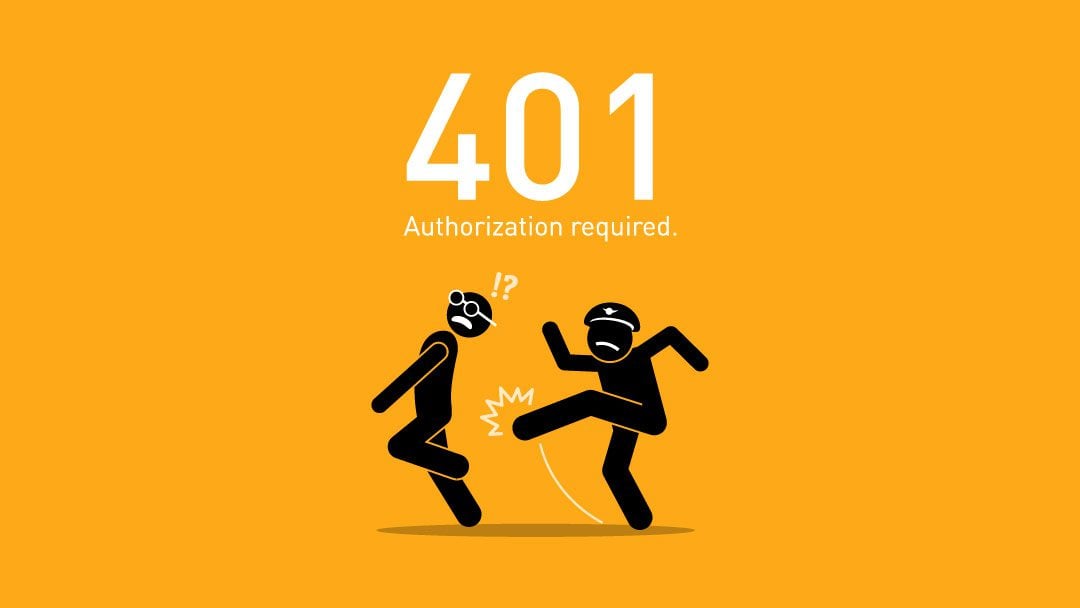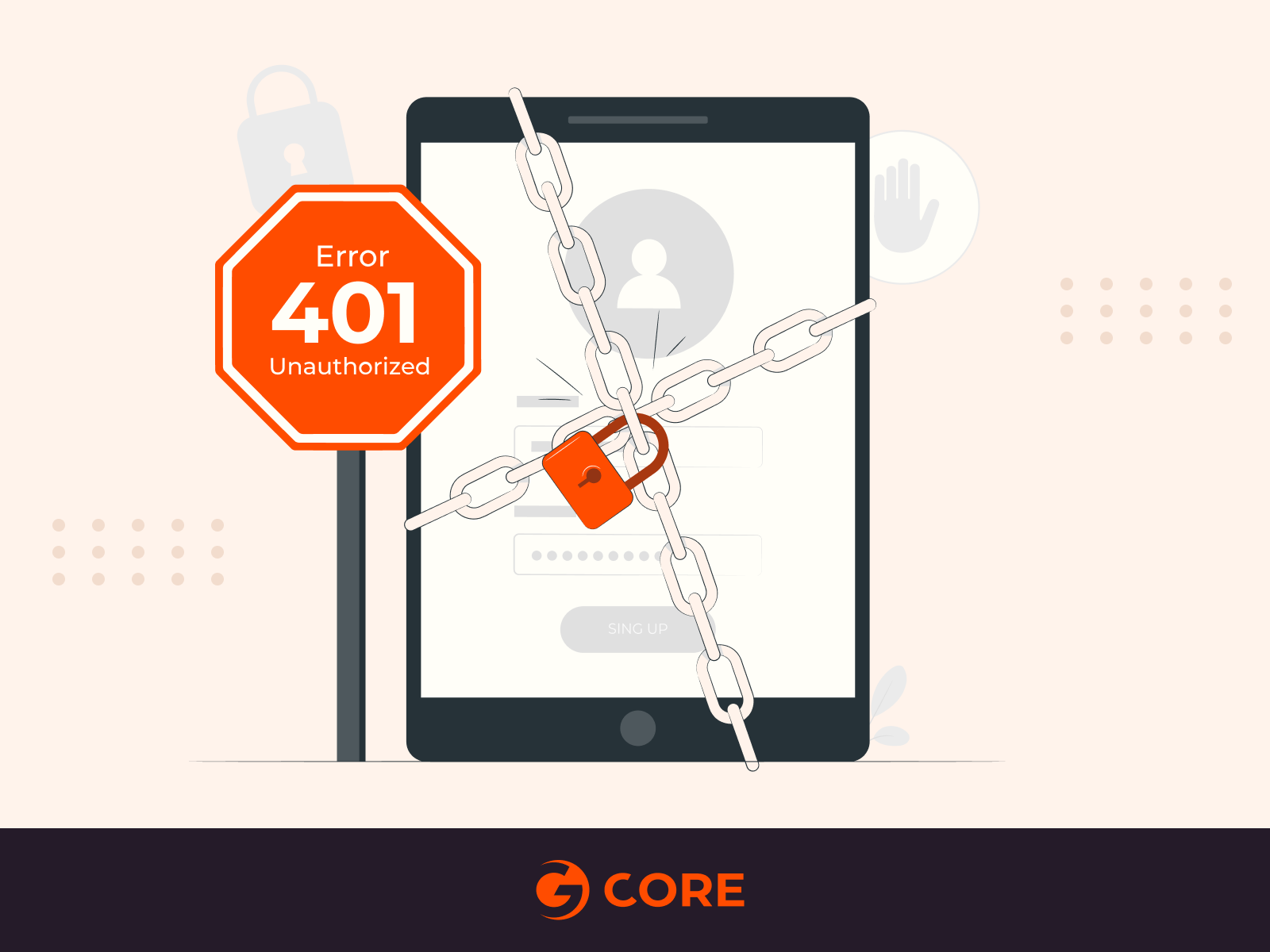A 401 error means you are not authorized to access a website. It often appears when login credentials are incorrect or missing.
Encountering a 401 error can be frustrating, especially when you need to access important information. This error serves as a gatekeeper, ensuring only authorized users can proceed. While it may seem like a roadblock, fixing a 401 error is often straightforward.
Understanding why this error occurs is the first step toward resolving it. Whether you are dealing with incorrect login details or a more complex issue, knowing how to address a 401 error will save you time and hassle. In this post, we will explore the causes of a 401 error and guide you through the steps to fix it.

Credit: www.web.com
Introduction To 401 Error
Encountering a 401 error can be frustrating. This error indicates an issue with authentication. It means the request lacks valid credentials. Understanding the root cause is essential. Fixing it can help improve website security and user experience.
Basics Of 401 Error
A 401 error is an HTTP status code. It signals that the request requires user authentication. The server refuses to process the request without valid credentials. This error often occurs when accessing a restricted page. Incorrect login details can also trigger it.
Importance Of Addressing 401 Errors
Addressing 401 errors is crucial. It ensures users can access necessary content. These errors can disrupt user experience. They may also indicate potential security vulnerabilities. Fixing them helps maintain website security. It also improves user trust and satisfaction.

Credit: www.elegantthemes.com
Common Causes Of 401 Errors
Encountering a 401 Error can be frustrating. This error indicates that the request lacks valid authentication credentials. Understanding the common causes of 401 Errors can help you resolve them quickly. Below are the typical reasons why you might see this error:
Authentication Issues
One of the most frequent causes of 401 Errors is authentication issues. This occurs when the server cannot verify the user’s credentials. Here are some common authentication problems:
- Incorrect Credentials: Users often enter the wrong username or password.
- Expired Password: Passwords may have expired, leading to failed authentication.
- Account Lockout: Multiple failed login attempts can lock the account.
Server Configuration Problems
Server configuration problems can also lead to 401 Errors. These issues often stem from how the server is set up to handle authentication:
- Misconfigured Authentication Settings: Incorrect settings in the server’s configuration files can cause errors.
- Incorrect File Permissions: Files or directories may not have the correct permissions, preventing access.
- IP Restrictions: Servers may restrict access to specific IP addresses, causing 401 Errors for unauthorized IPs.
Addressing these common causes can help you resolve 401 Errors efficiently. Always check both authentication issues and server configuration problems when troubleshooting.
Identifying 401 Errors
Experiencing a 401 Error can be frustrating. It means you’re unauthorized to access a web page. Identifying these errors is crucial to resolving them quickly. Let’s explore how to identify 401 errors efficiently.
Browser Indicators
Browsers often display clear messages for 401 errors. Look for phrases like “Unauthorized” or “Authorization Required”. These messages usually appear in the browser window. Sometimes, the error code 401 will be directly shown. These indicators help you know that the issue is with user authentication.
Server Logs
Server logs provide detailed information about 401 errors. Check the access logs on your server. They contain entries for each request made to your site. Look for log entries with the status code 401. They often include the time, IP address, and requested URL. This data helps you pinpoint the source of the error.
| Log Entry Component | Description |
|---|---|
| Time | When the error occurred |
| IP Address | The user’s IP address |
| Requested URL | URL that caused the error |
| Status Code | Should be 401 for unauthorized access |
By analyzing both browser indicators and server logs, you can quickly identify 401 errors. This is the first step to fixing the issue and ensuring smooth access to your website.

Credit: kinsta.com
Fixing Authentication Problems
Encountering a 401 Error on your website can be frustrating. This error means the server can’t verify your credentials. The issue often lies in authentication problems. Let’s explore ways to fix these.
Correcting Credentials
Incorrect credentials are a common cause of the 401 Error. Ensure you are entering the right username and password. Here are steps to correct credentials:
- Double-check your username and password for typos.
- Check if your Caps Lock is on.
- Try resetting your password if you can’t remember it.
If you are still facing issues, there might be a problem with saved passwords in your browser. Clear the browser’s cache and saved logins:
- Go to your browser’s settings.
- Find the option to clear browsing data.
- Select cache and saved passwords.
- Clear the data.
Updating Permissions
Sometimes, the 401 Error arises from inadequate permissions. Check if your account has the right access levels. Here’s how you can update permissions:
| Action | Steps |
|---|---|
| Verify User Roles |
|
| Update Access Rights |
|
Make sure to refresh the page after updating permissions. This ensures the changes take effect.
Resolving Server Configuration Issues
Encountering a 401 Error can be frustrating. It usually indicates that the server has denied your request due to invalid or missing authentication credentials. One of the common reasons for this error is server configuration issues. Resolving these issues can help restore access and ensure smooth functioning. In this section, we will explore ways to fix server configuration problems causing 401 Errors.
Checking File Permissions
Improper file permissions can lead to a 401 Error. Ensure that the files and directories on your server have the correct permissions. Here’s a simple guide to check and correct file permissions:
- Connect to your server using an FTP client or SSH.
- Navigate to the directory containing the affected files.
- Check the current permissions using the
ls -lcommand (for SSH) or by right-clicking on files (for FTP). - Set the correct permissions using the
chmodcommand. For example,chmod 644 filenamefor files andchmod 755 directorynamefor directories.
Ensure permissions are set properly to prevent unauthorized access while allowing legitimate requests.
Adjusting Security Settings
Security settings on your server can also cause a 401 Error. These settings may block access even if the credentials are correct. Review and adjust these settings to resolve the error:
- Access your server’s control panel or configuration files.
- Review the authentication methods set up in your server configuration files, such as
.htaccessorweb.config. - Ensure that the necessary authentication modules are enabled.
- Adjust any IP restrictions or user access controls that may be too restrictive.
After making changes, restart your server to apply the new settings. This should help resolve any authentication issues causing the 401 Error.
Preventing Future 401 Errors
Experiencing a 401 error can be frustrating. But knowing how to prevent these errors is crucial for maintaining a smooth user experience. This section explores some practical steps to prevent future 401 errors.
Regular System Audits
Regular system audits help in identifying potential issues before they become major problems. Conducting these audits involves checking user authentication processes, permissions, and access controls.
- Check user roles: Ensure all user roles are correctly assigned.
- Review permissions: Verify that permissions align with user roles.
- Update expired tokens: Regularly update expired tokens to maintain access.
Regular audits can prevent unauthorized access and ensure all users have the correct permissions.
Implementing Best Practices
Implementing best practices can significantly reduce the occurrence of 401 errors. This involves adhering to industry standards and using secure authentication methods.
- Use secure passwords: Encourage users to create strong, unique passwords.
- Enable two-factor authentication: Add an extra layer of security.
- Implement HTTPS: Ensure secure communication between servers and clients.
These practices help in maintaining a secure and efficient system, minimizing the risk of unauthorized access.
In summary, regular system audits and implementing best practices are essential in preventing 401 errors. By following these steps, you can ensure a secure and smooth user experience.
Tools To Troubleshoot 401 Errors
Encountering a 401 error can be frustrating. This error means you’re not authorized to access the webpage. To fix it, you need the right tools. Below are some effective tools to troubleshoot 401 errors.
Diagnostic Software
Diagnostic software can help identify the root cause of a 401 error. These tools provide detailed insights into server responses and authentication issues.
- Postman: This tool lets you test APIs. You can check if your API requests are correctly authenticated.
- Wireshark: This network protocol analyzer captures and displays packets. It helps identify where the authentication fails.
- Fiddler: This web debugging proxy logs all HTTP(s) traffic. It helps to inspect and debug traffic between your computer and the web.
Browser Developer Tools
Most modern browsers come with developer tools. These tools are built-in and can help you analyze the 401 error directly from your browser.
To use these tools, follow these steps:
- Open your browser (Chrome, Firefox, Edge).
- Press F12 or right-click on the page and select Inspect.
- Go to the Network tab.
- Refresh the page to capture the network activity.
- Look for the request that results in a 401 status code.
The Network tab will show you the request headers, response headers, and other important details. This helps you understand why the authorization failed.
Using diagnostic software and browser developer tools can greatly aid in resolving 401 errors. These tools provide detailed information, making troubleshooting easier and more effective.
When To Seek Professional Help
Facing a 401 error can be frustrating. Seek professional help if troubleshooting steps fail. Experts can quickly diagnose and fix the issue.
Dealing with a 401 Error can be frustrating. Sometimes, the issue might be beyond basic fixes. Knowing when to seek professional help can save time and effort. Let’s explore situations where expert advice is essential.
Persistent Errors
If the 401 Error keeps appearing, it may need expert attention. Sometimes, the problem is not just a wrong password. Persistent errors might signal a deeper issue. A professional can diagnose and fix these recurring problems.
Complex Systems
Some websites have complex security systems. These systems can cause 401 Errors. If your website has advanced features, fixing a 401 Error might be tough. Experts understand these systems. They can provide solutions without causing more issues.
“`
Frequently Asked Questions
What Is A 401 Error?
A 401 error means the server denied access due to invalid credentials.
Why Do I Get A 401 Error?
You get a 401 error because the server cannot authenticate your request.
How Can I Fix A 401 Error On My Website?
Check your login credentials. Update them if needed. Clear browser cache.
Can A 401 Error Happen Due To Expired Credentials?
Yes, expired credentials can cause a 401 error. Renew your login details.
Is A 401 Error Related To User Permissions?
Yes, a 401 error often relates to incorrect or insufficient user permissions.
Conclusion
A 401 error can be frustrating but is usually easy to fix. Check your login credentials first. Ensure your browser is updated. Clear your browser cache. Disable any conflicting plugins. Still facing issues? Contact the website administrator for help. Understanding these steps can save you time and stress.
Fixing a 401 error doesn’t need to be complicated. Follow these tips for a smoother online experience.
